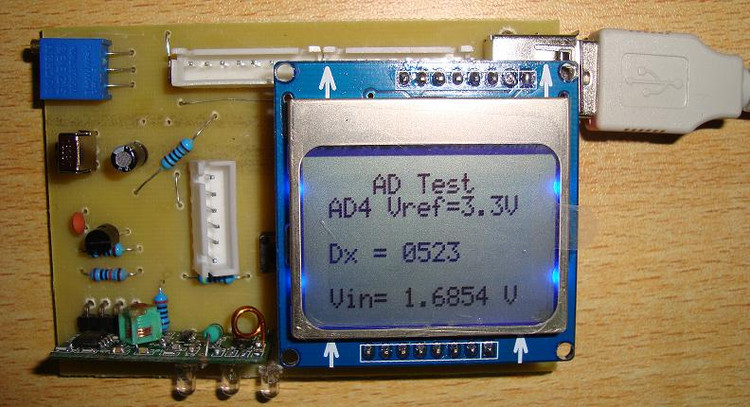
/*************PIC16F917 MCU program******************************/
/************************************************************************/
/*****File Function : AD acquisition, LCD display program *****/
/*****Program Author : ZhengWen(ClimberWin) *****/
/*****MCU : PIC16F917 internal crystal oscillator *****/
/*****Compile Date : 2010/08/18 *****/
/*****Edition Info : V1.0 *****/
/*********************************************************************/
//Measure AD and display it through LCD
//Pin definition: PORTD=8LED, KEY=RB0(INT) RA5(AN4) as AD input
/*Modification Date: */
/************************************/
#include
#include "english_6x8_pixel.h"
#define uchar unsigned char
#define uint unsigned int
void Init(void); //初始化子程序
void LCD_init(void); //LCD初始化程序
void LCD_clear(void);
void LCD_write_char(unsigned char c);
void LCD_set_XY(unsigned char X, unsigned char Y);
void LCD_write_english_string(unsigned char X,unsigned char Y,const char *s);
void LCD_write_byte(unsigned char data, unsigned char command);
void delayms(unsigned int count);
void interrupt ADint(void);
#define KEY RB0
#define SPI_CLK RD0
#define SPI_MOSI RD1
#define LCD_DC RD2
#define LCD_CE RD3
#define LCD_RST RD4
/***********************************************/
const unsigned char mask_table[8]={0x80,0x40,0x20,0x10,0x08,0x04,0x02,0x01};
float ad_data;//AD数据存储地址
uchar temp1,temp2;
uint temp3;
/*********************************************/
void delayms(unsigned int count)
{
uint i,j;
for(i=0;i
}
/*********************************************/
void Init(void)
{
PORTA = 0B00000000;
PORTB = 0B00000000;
PORTD = 0B00000000;
TRISA = 0B00100010; //Set RA5 (AN4) RA1 as input
TRISB = 0B00100001; //Set RB0 as input, as a key port
TRISD = 0B00000000; //Set PORTD as output, as LCD/LED display port
RD5=1; //Turn off LED
RD6=1;
RD7=1;
///////////AD configuration////////////////////////////////////////
ANSEL= 0B00010000; //Select AN4 as AD input (PDF 148)
ADCON0=0B10010001; //AD result format Right justified, select reference voltage VDD-VSS, AN4 input, turn off AD conversion
ADCON1=0B01010000; //AD conversion clock selection
ADIE=1;//AD interrupt enable
PEIE=1;
ADIF=0;//clear interrupt flag
GIE=1; //enable general interrupt
/////////////////////////////////////
LCD_init(); //initialize LCD
}
void interrupt ADint(void)
{
temp1=ADRESL;
temp2=ADRESH;
temp3=temp2*256+temp1; //Dx value
ad_data=(temp3*33000)/1024; //voltage value
ADIF=0; //clear interrupt flag
}
void LCD_init(void)
{
LCD_RST=0; //LCD reset
NOP();
LCD_RST=1;
LCD_CE=0 ; //Disable LCD
NOP();
LCD_CE=1; //Enable LCD
NOP();
LCD_write_byte(0x21, 0); // Use extended commands to set LCD mode
LCD_write_byte(0xc8, 0); // Set bias voltage
LCD_write_byte(0x06, 0); // Temperature correction
LCD_write_byte(0x13, 0); // 1:48
LCD_write_byte(0x20, 0); // Use basic commands
LCD_clear(); // Clear the screen
LCD_write_byte(0x0c, 0); // Set display mode, normal display
LCD_CE=0 ; // Turn off LCD
}
/////////LCD清屏程序/////////////
void LCD_clear(void)
{
uint i;
LCD_write_byte(0x0c, 0);
LCD_write_byte(0x80, 0);
for (i=0; i<504; i++)
LCD_write_byte(0x00, 1);//清零
}
///////////设置LCD坐标///////////////////
void LCD_set_XY(unsigned char X, unsigned char Y)
{
LCD_write_byte(0x40 | Y, 0);
LCD_write_byte(0x80 | X, 0);
}
/////////////////Character display program/////////////////////
void LCD_write_char(unsigned char c)
{
uint line;
c=c-32;
for (line=0; line<6; line++)
LCD_write_byte( font6x8[c][line], 1);
}
/////////////////打印字符串/////////////////////////
void LCD_write_english_string(unsigned char X,unsigned char Y, const unsigned char *s)
{
uchar i = 0;
LCD_set_XY(X,Y);
while(*s) {LCD_write_char(*s++);}
}
////////////Write data to LCD//////////////////////
void LCD_write_byte(unsigned char data, unsigned char command)
{
uchar i;
LCD_CE=0 ; // Enable LCD
if (command == 0)
{LCD_DC=0 ;} // Send commandelse
{
LCD_DC=1 ;} // Send datafor
(i=0;i<8;i++)
{
if(data&mask_table[i])
{SPI_MOSI=1;}
else
{SPI_MOSI=0;}
SPI_CLK=0;
NOP();
SPI_CLK=1;
}
LCD_CE=1; // Turn off LCD
}
/////////////Main program///////////////////////////
void main (void)
{
Init();//初始化程序
LCD_clear(); //LCD清屏
delayms(1000);
LCD_write_english_string(0,0," AD Test " );
LCD_write_english_string(0,1,"AD4 Vref=3.3V" );
ADCON0=ADCON0|0B00000010;//开始AD转换
LCD_set_XY(0,3);
LCD_write_char('D');
LCD_write_char('x');
LCD_write_char(' ');
LCD_write_char('=');
LCD_set_XY(0,5);
LCD_write_char('V');
LCD_write_char('i');
LCD_write_char('n');
LCD_write_char('=');
LCD_set_XY(72,5);
LCD_write_char('V');
while(1)
{
LCD_set_XY(30,3);
LCD_write_char((temp3/1000)+16+32);
LCD_write_char( (temp3%1000)/100+16+32);
LCD_write_char( ((temp3%1000)%100)/10+16+32);
LCD_write_char( ((temp3%1000)%100)%10+16+32);
//ad_data=ad_data*10000;
temp3=(uint)ad_data;
LCD_set_XY(30,5);
LCD_write_char((temp3/10000)+16+32);
LCD_write_char('.');
LCD_write_char( (temp3%10000)/1000+16+32);
LCD_write_char( ((temp3%10000)%1000)/100+16+32);
LCD_write_char( (((temp3%10000)%1000)%100)/10+16+32);
LCD_write_char( (((temp3%10000)%1000)%100)%10+16+32);
delayms(100);
ADCON0=ADCON0|0B00000010; //Start AD conversion
}
}
Previous article:PIC16F917 NOKIA5110 LCD arbitrary dot drawing program
Next article:PIC16F917 NOKIA5110 LCD test program
 Professor at Beihang University, dedicated to promoting microcontrollers and embedded systems for over 20 years.
Professor at Beihang University, dedicated to promoting microcontrollers and embedded systems for over 20 years.
- Innolux's intelligent steer-by-wire solution makes cars smarter and safer
- 8051 MCU - Parity Check
- How to efficiently balance the sensitivity of tactile sensing interfaces
- What should I do if the servo motor shakes? What causes the servo motor to shake quickly?
- 【Brushless Motor】Analysis of three-phase BLDC motor and sharing of two popular development boards
- Midea Industrial Technology's subsidiaries Clou Electronics and Hekang New Energy jointly appeared at the Munich Battery Energy Storage Exhibition and Solar Energy Exhibition
- Guoxin Sichen | Application of ferroelectric memory PB85RS2MC in power battery management, with a capacity of 2M
- Analysis of common faults of frequency converter
- In a head-on competition with Qualcomm, what kind of cockpit products has Intel come up with?
- Dalian Rongke's all-vanadium liquid flow battery energy storage equipment industrialization project has entered the sprint stage before production
- Allegro MicroSystems Introduces Advanced Magnetic and Inductive Position Sensing Solutions at Electronica 2024
- Car key in the left hand, liveness detection radar in the right hand, UWB is imperative for cars!
- After a decade of rapid development, domestic CIS has entered the market
- Aegis Dagger Battery + Thor EM-i Super Hybrid, Geely New Energy has thrown out two "king bombs"
- A brief discussion on functional safety - fault, error, and failure
- In the smart car 2.0 cycle, these core industry chains are facing major opportunities!
- The United States and Japan are developing new batteries. CATL faces challenges? How should China's new energy battery industry respond?
- Murata launches high-precision 6-axis inertial sensor for automobiles
- Ford patents pre-charge alarm to help save costs and respond to emergencies
- New real-time microcontroller system from Texas Instruments enables smarter processing in automotive and industrial applications
- Here is the camera information on the national competition list
- RF Components Test Technology Seminar for 5G - You are invited to attend!
- Has anyone designed this power supply?
- Network Control of ROS Melodic
- Let’s take a look at how this overvoltage protection circuit can be optimized?
- Inverter and Motor Control
- 【ST NUCLEO-H743ZI Review】(2) First experience with Ethernet testing
- Disassembling a common fire emergency light
- [NXP Rapid IoT Review] Mobile APP connection finally succeeded
- Buy an oscilloscope and get the essential analysis software 5-PWR for power engineers

 AD0809 Digital Voltmeter Based on Single Chip Microcomputer
AD0809 Digital Voltmeter Based on Single Chip Microcomputer Application of Proteus in MCS&ARM: Digital_Voltmeter
Application of Proteus in MCS&ARM: Digital_Voltmeter AP358SA
AP358SA











 京公网安备 11010802033920号
京公网安备 11010802033920号